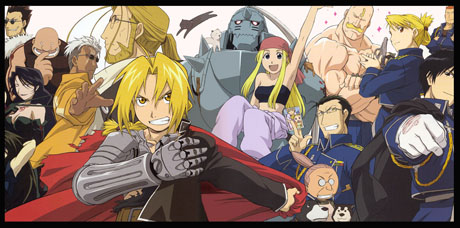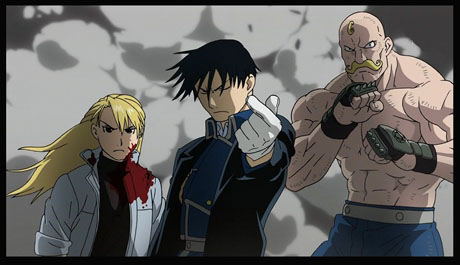
Hiromu Arakawa’s “Fullmetal Alchemist” was one of the first successful adventure manga created by a woman. Ordinarily, the animated versions would be classified as shonen (boy’s) series, but the complex characters and intriguing plot attracted fans of both genders—on both sides of the Pacific.
“Fullmetal” centers on the prodigies Edward and Alphonse Elric. The boys violated alchemy’s greatest taboo by trying to bring their mother back from the dead. (“We just wanted to see Mom’s smile again,” Al explains.) Their attempt at “human transmutation” cost Ed his left leg; Al nearly died, but Edward sacrificed his right arm to affix his brother’s soul to a suit of armor with a magical sign drawn in blood. Their friend Winrey and her grandmother crafted the “automail,” robotic prostheses that earn Ed the title of Fullmetal Alchemist.

Wracked by guilt, Ed searches for a way to restore his brother’s body as they roam through a world that resembles late 19th century Europe. Their studies reveal that only a Philosopher’s Stone can heal them. Alchemy must obey the principle of Equivalent Exchange: For everything taken, something of equal value must be given. A Philosopher’s Stone isn’t bound by that law and seems to offer unlimited power. But, like Tolkien’s One Ring, the Stone is inherently evil. Human lives must be sacrificed to create one.
Few American animated characters have to face the moral quandary Ed wrestles with: Does he attempt to manufacture a Stone or does he leave his beloved brother without a body?
Fullmetal Alchemist (2003) was animated before Arakawa had completed the manga; director Seiji Mizushima and his writers had to create an ending. They gave it an odd twist that took Ed and Al to Weimar Germany: That storyline concluded in the feature The Conqueror of Shambala (2005).
The darker, more dramatic and more exciting remake Fullmetal Alchemist: Brotherhood (2009) follows the story to Arakawa’s conclusion. Although the filmmakers expanded the series from 51 episodes to 63, many of the side stories were shortened or eliminated. The extended length and tighter focus enables the viewer to follow the plot more closely and learn more about the Elrics and their world.
Director Yasuhiro Irie pulls out all the stop in the climactic battle that pits the Elric Brothers and their friends against “Father,” the dark master of the soulless creatures known as Homunculi. “Father” plans to obtain god-like power by slaughtering the population an entire country to create a gigantic Philosopher’s Stone.
But the CG effects are eclipsed by the human emotions that underlay the battle. All of the main characters are tested, and must overcome their weaknesses to ensure the defeat of evil. As Edward and Alphonse face dire challenges, they demonstrate the depth of their bond through the sacrifices they willingly make for each other. Their actions give the battle and its resolution the powerful conclusion the series demands.

The handsomely packaged reissue by Aniplex features new cover art by Arakawa and a booklet with short biographies of the characters. The extras include four OVA’s and the 16 mini-episodes of the “Comic Theater.” The slapstick encounters of the “Comic Theater” echo the four-panel cartoons Arakawa drew at the end of the manga collections. The characters are rendered in a cartoony “SD” (“super-deformed”) style, and the result suggests the animated equivalent of a blooper reel.
The four OVA adventures offer short stories about the main characters’ pasts. “Simple People” reveals an unexpected bond between automail artisan Winrey and sharpshooter Lt. Hawkeye. “A Master’s Tale” shows that the Elrics’ teacher, Izumi-sensei, was even a redoubtable teen-ager: The carcass of a bear she killed helped win her future husband’s heart. “Yet Another Man’s Battlefield” explains how the Elrics’ friends Roy Mustang and Maes Hughes forged the bond that figures in the main narrative. The chilling “Blind Alchemist” reminds Edward and Alphonse of the terrible consequences of attempting human transmutation.
The drawings in The Complete Art of Fullmetal Alchemist have been assembled from book and magazine covers, calendars, phone cards and other printed sources that were published between 2001 and 2010. Arakawa favors clean, bold lines that work well with areas of strong color. The red of Ed’s coat and the goldenrod of his hair contrast effectively with the silver-gray of Al’s suit of armor and the royal blue of the uniforms of the Elrics’ military friends (and foes). In addition to illustrating scenes from the main narrative, Arakawa shows her cast in traditional Japanese dress celebrating a holiday and goofing off behind the scenes. Neither Ed nor Arakawa show any self-consciousness about Ed’s prostheses: He plays volleyball and horses around with his brother in a tank top and shorts. In American animation, only Hiccup in the How to Train Your Dragon films handles a lost limb with such comfortable ease. In the afterword, Arakawa takes the reader through a step-by-step explanation of how she created a special illustration of the entire cast of “Fullmetal.”
Despite their popularity, there have been no new adventures for Ed and Alphonse—in prinut or on the screen–since the feature The Sacred Star of Milos in 2011. Brotherhood brought the Elrics’ adventures to a definitive conclusion. At a time when theaters are awash in unnecessary sequels, Arakawa knows her saga is over. Viewers might regard the sacrifice of additional adventures as the price of an satisfying ending to the main story: A real-world example of Equivalent Exchange.
Fullmetal Alchemist: Brotherhood: Blu-Ray Box Set I
Aniplex: $99.98 7 discs
Fullmetal Alchemist: Brotherhood: Blu-Ray Box Set II
Aniplex: $99.98 7 discs
The Complete Art of Fullmetal Alchemist
by Hiromu Arakawa
Viz: $34.99, 288 pp.
- Charles Solomon’s Animation Year End Review 2023 - December 28, 2023
- INTERVIEW: Makoto Shinkai on “Suzume” - November 27, 2023
- Interesting Portrayals of Gay Men in Manga/Anime - June 12, 2023


 November 16th, 2018
November 16th, 2018  Charles Solomon
Charles Solomon  Posted in
Posted in  Tags:
Tags: 






